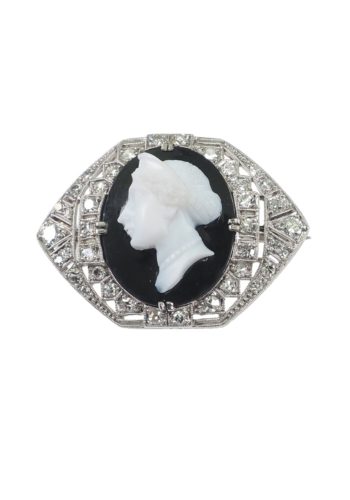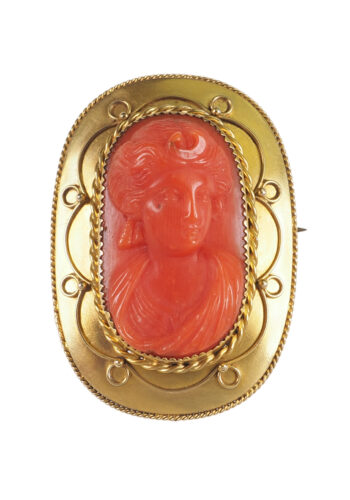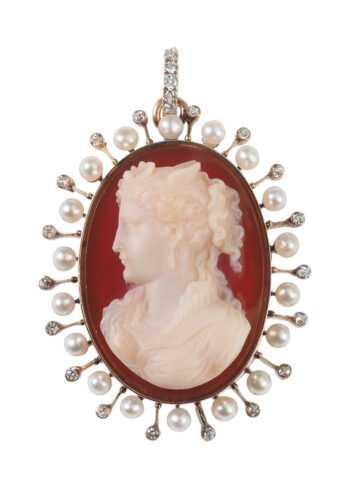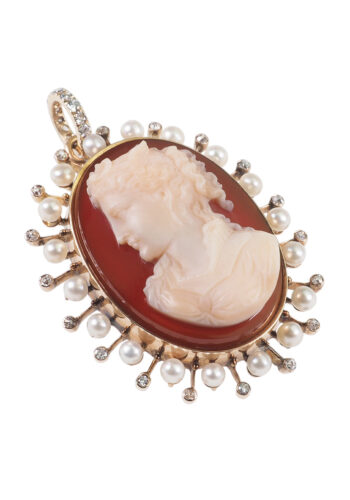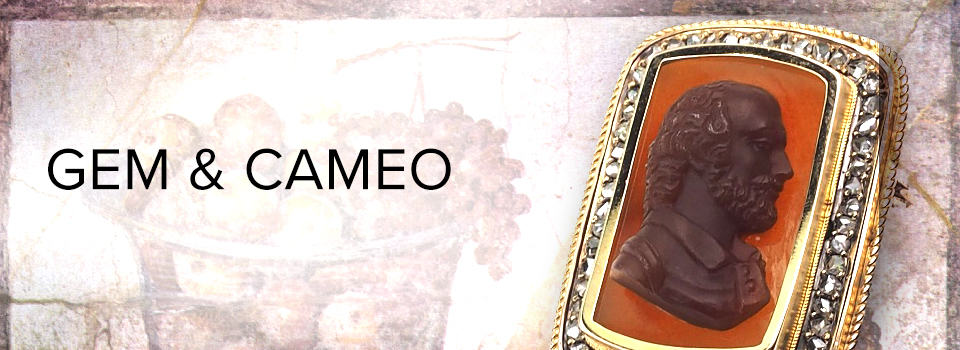
Gem & Cameo
A raised cut relief in a gemstone or a shell is called cameo. By the different colourings of the raw material in layers or by the 'height', the shown motive contrasts mostly brightly with the deeper basis. Most jewellery cameos originated from shells. Nevertheless, nearly every and carveable material used during the antique jewellery production had been refined to cameos. The cameo appears in the antique jewellery also in alternative spellings, like kameo, cameo and camée. We introduce you to the variously used materials here.
Click to fold
The stone cameo
Stone cameos are carved mainly from agates. These banded layer stones were predestined for the cameo carving. Onyx, sardonyx and cornelian are the most often appearing variations. The treatment of these materials is much more difficult than with softer materials, indeed, the result is also much more detailed and is finer than with softer materials.The shell cameo
Shell cameos became more popular about 1800 again, after their manufacturing experienced a decline in the time after the Renaissance. Shells are softer than layer stones and are easier and therefore and quicker to work on. The woodcarvers chose shells with ideally 3 layers to create the illusion of a most possible three-dimensionality. A big biodiversity of shells enabled a big colour variety in the jewellery creation.The coral cameo
Since antique times the coral is a talisman against evil spirits and has originated after the legend when Perseus had killed Medusa and her blood flowed into the sea. The coral, which was mainly used in the jewellery creation, was ‚corallium rubrum‘ whose colour spectrum ranges from dark red up to the brightest salmon tones. The coral was treated always a lot more sculptural than the relief-like presentations on the shell cameos.The lava cameo
A curiosity of a special kind is the so-called lava jewellery in the cameo carving. Actually, it is limestone, which was extracted at the foot of Vesuvius and was sold for marketing-technical reasons as lava. Since the 1840s it was a popular tourist jewellery for wealthy travellers on the Grand Tour. Lava cameos fascinate by their very big three-dimensionality and emit therefore an amazing liveliness.The gem
The opposite of a cameo is a gem. With the gem the motive is cut recessed into the material. The gemstones, which were worked on in that way, are also called ‚intaglio‘. The gem, which is already known since approx. 6 millenniums, is the name father for the gemology. Cameos were already cut by the old Egyptians, Persians and Greeks. The ideal materials for it were stones of the quartz group, as chalzedone and sardonyxe (layer stones). Till this day they are still used in the jewellery design, with antique man’s rings, for example, as signet rings.Click to fold
-
Ca. 1870 – Shell Cameo Gold Earrings 15K Viktorian
€ 1.490,00
differential tax applies collectors items and antiques in accordance with German law §25a UStGFree Shipping -
Ca. 1900 – “St Joseph with Baby Jesus” Pendant with Gold Chain
€ 990,00
differential tax applies collectors items and antiques in accordance with German law §25a UStGFree Shipping -
Ca. 1865 – French Gold Earrings with Onyx Cameos
€ 2.400,00
differential tax applies collectors items and antiques in accordance with German law §25a UStGFree Shipping -
Ca. 1920 – Platinum Brooch with Diamonds & Onyx Stone cameo, Art déco England
€ 2.900,00
differential tax applies collectors items and antiques in accordance with German law §25a UStGFree Shipping -
Ca. 1880 – 18 ct. Gold Brooch / Chain pendant with Cornelian cameo & Old-cut Diamonds, French
€ 3.500,00
differential tax applies collectors items and antiques in accordance with German law §25a UStGFree Shipping -
Ca. 1860 – 15 ct. Gold Brooch with Coral Cameo Victorian Italy
€ 1.290,00
differential tax applies collectors items and antiques in accordance with German law §25a UStGFree Shipping -
Ca. 1860 – Shell Cameo French Gold Earrings
€ 1.290,00
differential tax applies collectors items and antiques in accordance with German law §25a UStGFree Shipping -
Ca. 1870 – Shell Cameos French Gold Earrings
€ 1.690,00
differential tax applies collectors items and antiques in accordance with German law §25a UStGFree Shipping -
Ca. 1880 – French Carnelian Cameo Pendant with Diamonds & Pearls
€ 3.900,00
differential tax applies collectors items and antiques in accordance with German law §25a UStGFree Shipping -
Ca. 1880 – Victorian English Gold Earrings / Carnelian Cameos
€ 1.390,00
differential tax applies collectors items and antiques in accordance with German law §25a UStGFree Shipping -
Ca. 1850 – Italian Coral Earrings / 18 ct. Yellow-gold
€ 1.990,00
differential tax applies collectors items and antiques in accordance with German law §25a UStGFree Shipping -
Ca. 1870 – Etruscan Revival Pendant with Carnelian Cameo
€ 1.890,00
differential tax applies collectors items and antiques in accordance with German law §25a UStGFree Shipping -
Ca. 1880 – Signet ring made of Gold, with Carnelian Intaglio
€ 2.400,00
differential tax applies collectors items and antiques in accordance with German law §25a UStGFree Shipping -
Ca. 1840 – Carnelian Cameos Gold Earrings, French
€ 2.500,00
differential tax applies collectors items and antiques in accordance with German law §25a UStGFree Shipping -
Ca. 1880 – Victorian Silver Necklace with Shell Cameos
€ 650,00
differential tax applies collectors items and antiques in accordance with German law §25a UStGFree Shipping -
Ca. 1880 – Onyx Cameo Gold Ring, French
€ 3.400,00
differential tax applies collectors items and antiques in accordance with German law §25a UStGFree Shipping -
Ca. 1860 – Jet Brooch with Cameo Victorian England
€ 390,00
differential tax applies collectors items and antiques in accordance with German law §25a UStGFree Shipping -
Ca. 1860 – Pinchbeck Earrings with Shell Cameos, English
€ 890,00
differential tax applies collectors items and antiques in accordance with German law §25a UStGFree Shipping -
Ca. 1860 – Cameo Brooch Shell England
€ 640,00
differential tax applies collectors items and antiques in accordance with German law §25a UStGFree Shipping -
Ca. 1890 – Agate Cameo Gold Pendant with Chain
€ 1.190,00
differential tax applies collectors items and antiques in accordance with German law §25a UStGFree Shipping -
Ca. 1880 – Gold-plated Silver Earrings “Lava Cameos”
€ 390,00
differential tax applies collectors items and antiques in accordance with German law §25a UStGFree Shipping -
Ca. 1830 – Shell cameo Brooch with 18 ct. Gold frame, including original Box
€ 1.590,00
differential tax applies collectors items and antiques in accordance with German law §25a UStGFree Shipping -
Ca 1840 – Shell Cameo Brooch with Gold-plated frame, from France
€ 490,00
differential tax applies collectors items and antiques in accordance with German law §25a UStGFree Shipping -
Ca. 1870 – Shell cameos Gold Earrings, Victorian England
€ 790,00
differential tax applies collectors items and antiques in accordance with German law §25a UStGFree Shipping










